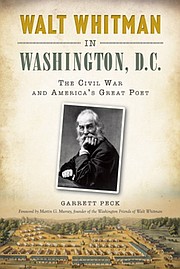Details
Garrett Peck will showcase his latest book “Walt Whitman in Washington, D.C.: The Civil War of America’s Great Poet” at One More Page Books, 2200 N Westmoreland St., #101, Tuesday, April 14 at 7 pm.
Arlington historian, author and tour guide Garrett Peck will showcase his latest book “Walt Whitman in Washington, D.C.: The Civil War of America’s Great Poet” at One More Page Books.
Peck always dreamed of writing a book about Walt Whitman.
“I started outlining and writing the book a number of years ago and worked on it, bit by bit. By the time I published ‘Capital Beer’ in March 2014, I knew I was going to write ‘Walt Whitman’ next,” he said.
He wanted the book’s release to coincide with the 150th anniversary of the Lincoln’s assassination.
“Walt Whitman in Washington, D.C.” takes a chronological view of Whitman’s 10 years in the area, including his three years as a volunteer "hospital missionary," making more than 600 hospital visits and serving more than 80,000 sick and wounded soldiers and his time as a federal clerk.
During the writing process, Peck’s greatest challenge was wading through the vast material of letters, newspaper articles and poems by Whitman as well as the writings of some of the main historians of the famous poet and condensing it into a 50,000 word book. He gathered a lot of his research from the Library of Congress’s Digital Collection.
Another challenge the author faced was trying to uncover the facts from Whitman’s embellishments.
In one of his early articles for the New York Times, Whitman mentioned seeing President Lincoln when he (Whitman) lived on Vermont Avenue. Years later in “Memorandum of the War,” a collection of these articles, Whitman added a line stating that he and President Lincoln would nod to each other in this same article.
“It made me wonder why he added that line 13 years later. Maybe he was trying to get some kind of acknowledgement from the president, even posthumously,” he said.
During his hospital visits, he met a soldier name Oscar Cunningham who had to have his leg amputated. Whitman watched him deteriorate from a strapping young man to a skeleton who died a month after his amputation.
“This event may have triggered the breakdown of Whitman’s health. Shortly after he suffered a breakdown in his health and had to return to Brooklyn to recuperate. It really shows how dealing with stress can significantly affect our physical health,” he said.
Another aspect of Whitman’s life includes his romantic relationship with Peter Doyle whom he met while taking the streetcar. There was also a significant age gap between the 21-year-old Irish immigrant and former Confederate soldier and Whitman who was 46 at the time they met.
During Whitman’s time in the city, he lived in six different boarding houses including one on Vermont Avenue near the White House and at the W Hotel, which is also the last stop of Peck’s Walt Whitman Tour.
“For the first Walt Whitman Tour, I took around a group of tour guides and showed them the places where he frequented, lived, worked and volunteered. There is history is everywhere, you just have to go find it,” Peck said.

